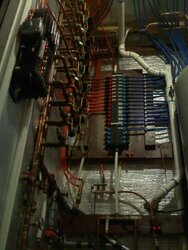If you do consider a propane on-demand hot water heater, I highly recommend the Takagi TK-Jr. Only $1000 installed with chimney and outdoor air kit and remote. It can handle a 5 gal/min flow, but since the thermostat can be set up to 180

, you can add a mixing valve to push much more than 5 gal/min to your fixtures at 120

. Also, at 180, there's no worry about bacteria. I use one of these for both domestic hot water and also hydronic heating. It really sips the propane, even though the wonderful consistent heat encourages long showers. Between this unit, cooking, and running a propane generator more often than usual, we're currently at around 30% of our 100 gal tank after filling up before Thanksgiving. I'll probably fill it again at the end of this month and then the end of March, and then not again until next November.



 , you can add a mixing valve to push much more than 5 gal/min to your fixtures at 120
, you can add a mixing valve to push much more than 5 gal/min to your fixtures at 120 
